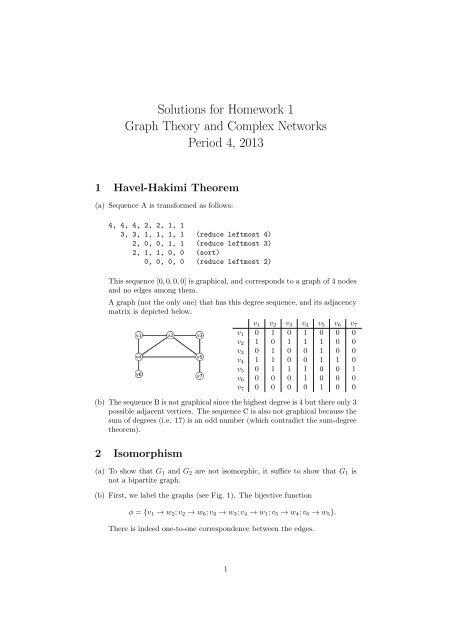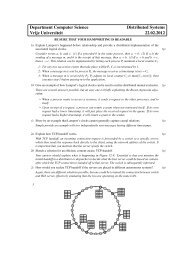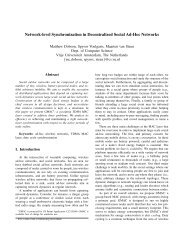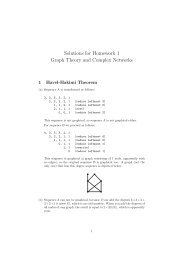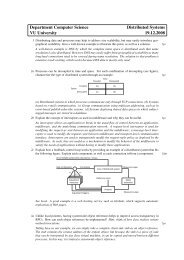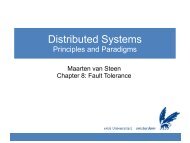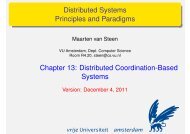Solutions for Homework 1 Graph Theory and Complex Networks ...
Solutions for Homework 1 Graph Theory and Complex Networks ...
Solutions for Homework 1 Graph Theory and Complex Networks ...
You also want an ePaper? Increase the reach of your titles
YUMPU automatically turns print PDFs into web optimized ePapers that Google loves.
<strong>Solutions</strong> <strong>for</strong> <strong>Homework</strong> 1<strong>Graph</strong> <strong>Theory</strong> <strong>and</strong> <strong>Complex</strong> <strong>Networks</strong>Period 4, 20131 Havel-Hakimi Theorem(a) Sequence A is trans<strong>for</strong>med as follows:4, 4, 4, 2, 2, 1, 13, 3, 1, 1, 1, 1 (reduce leftmost 4)2, 0, 0, 1, 1 (reduce leftmost 3)2, 1, 1, 0, 0 (sort)0, 0, 0, 0 (reduce leftmost 2)This sequence [0, 0, 0, 0] is graphical, <strong>and</strong> corresponds to a graph of 4 nodes<strong>and</strong> no edges among them.A graph (not the only one) that has this degree sequence, <strong>and</strong> its adjacencymatrix is depicted below.v 1 v 2 v 3 v 4 v 5 v 6 v 7v 1 0 1 0 1 0 0 0v 2 1 0 1 1 1 0 0v 3 0 1 0 0 1 0 0v 4 1 1 0 0 1 1 0v 5 0 1 1 1 0 0 1v 6 0 0 0 1 0 0 0v 7 0 0 0 0 1 0 0(b) The sequence B is not graphical since the highest degree is 4 but there only 3possible adjacent vertices. The sequence C is also not graphical because thesum of degrees (i.e. 17) is an odd number (which contradict the sum-degreetheorem).2 Isomorphism(a) To show that G 1 <strong>and</strong> G 2 are not isomorphic, it suffice to show that G 1 isnot a bipartite graph.(b) First, we label the graphs (see Fig. 1). The bijective functionφ = {v 1 → w 2 ; v 2 → w 6 ; v 3 → w 3 ; v 4 → w 1 ; v 5 → w 4 ; v 6 → w 5 }.There is indeed one-to-one correspondence between the edges.1
3 k-Regular <strong>Graph</strong>sFigure 1: Labelled graphs G 1 <strong>and</strong> G 3 .We observe that the the number of vertices n = 2k + 3 is odd, <strong>and</strong> constructthe Harary graph <strong>for</strong> odd n <strong>and</strong> odd k. So, Harary graph H k,2k+3 is G = (V, E)with V = {0, 1, 2, . . . , 2k + 2}. Its edge set E(G) can be constructed as follows:1. E 1 consists of the edges that connect every vertex i to its k/2 left-h<strong>and</strong>neighbors <strong>and</strong> to its k/2 right-h<strong>and</strong> neighbors;2. E 2 = {〈0, k + 1〉, 〈1, k + 2〉, . . . , 〈k + 1, 2k + 2〉}.So, the resulting edge set is E(G) = E 1⋃E2 .4 Feestje!People at the party can be represented as a graph with 55 nodes, <strong>and</strong> each hasexactly 5 edges. By the sum-degree theorem, the total number of edges wouldhave to be 55×52, which is not an integer. Hence, such a graph does not exist.5 Mathematica, basic functionalitySee solutions-1.nb file.2


